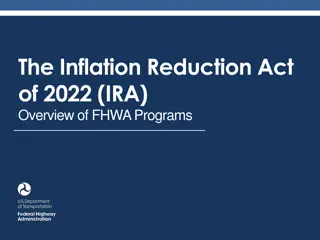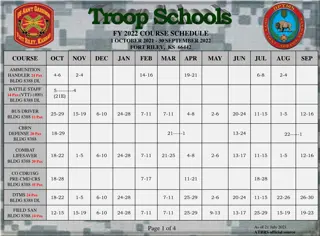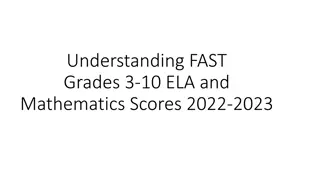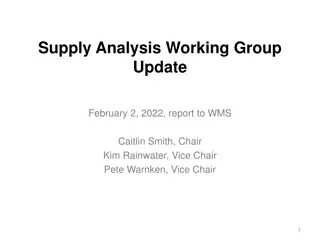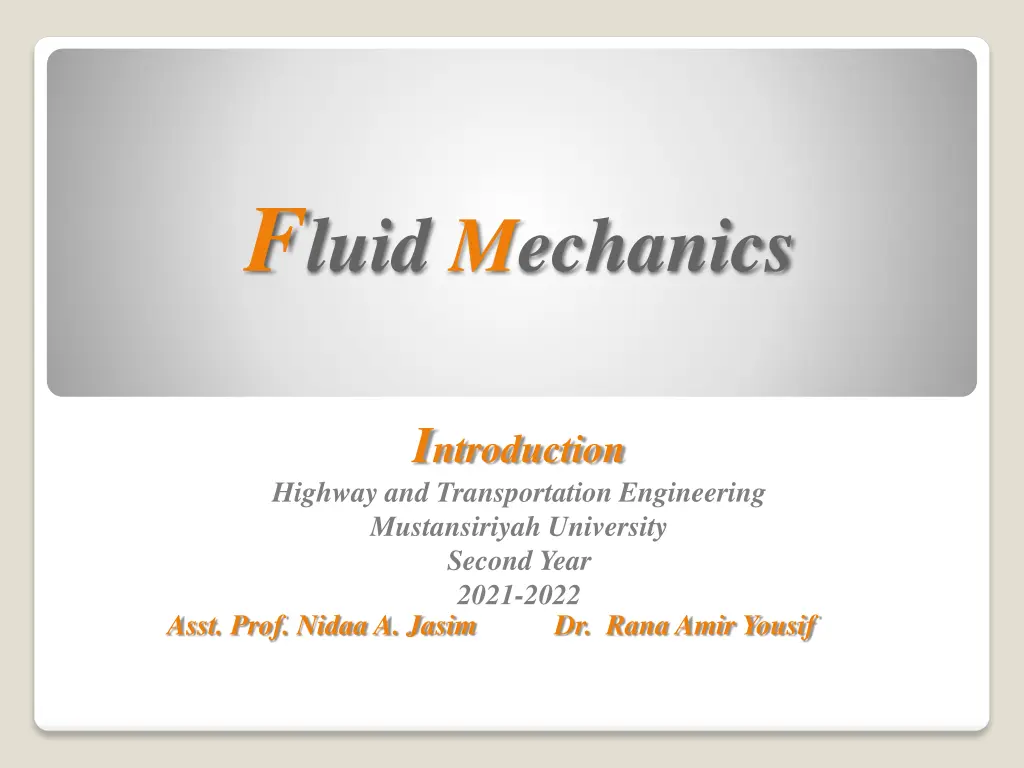
Fluid Mechanics Fundamentals and Applications
Explore the concepts of fluid mechanics in engineering, covering properties of fluids, forces on gates and dams, fluid dynamics, and more. Understand the fundamental units, forces, and weight in fluid systems. Discover the wide-ranging applications of fluid mechanics across various disciplines. Dive into the study of fluids at rest and in motion, along with practical considerations for flow in pipelines and channel classifications.
Download Presentation

Please find below an Image/Link to download the presentation.
The content on the website is provided AS IS for your information and personal use only. It may not be sold, licensed, or shared on other websites without obtaining consent from the author. If you encounter any issues during the download, it is possible that the publisher has removed the file from their server.
You are allowed to download the files provided on this website for personal or commercial use, subject to the condition that they are used lawfully. All files are the property of their respective owners.
The content on the website is provided AS IS for your information and personal use only. It may not be sold, licensed, or shared on other websites without obtaining consent from the author.
E N D
Presentation Transcript
Fluid Mechanics Introduction Highway and Transportation Engineering Mustansiriyah University Second Year 2021-2022 Asst. Prof. Nidaa A. Jasim Dr. Rana Amir Yousif
Syllabus: Introduction: Properties of fluids Archimedes theory. Atmosphere and gage pressure, measuring the fluid pressure on a point Calculating the fluid force on gates, dams. Forces consideration in fluids on inclined surfaces. Fluids in motion (Continuity & Bernoullis equations). Flow in pipeline (pressure, velocity, head). Methods for connecting the pipelines. Classification of channels at roads
References Fluid mechanics, Victor L. Streeter E. Bemjamin Wylie 7th edition ,Mc Graw Hill, 1979. Fluid Mechanics with Applications ANTHONY ESPOSITO Prentice Hall-1998
Introduction Definition : Fluid mechanics is the branch of Physics concerned with the Mechanics of fluids (liquids, gases, and plasmas) and the Forces on them as well as applications where fluid systems are used [1]. It has applications in a wide range of disciplines, including Mechanical, Civil and Biomedical engineering, geophysics, Oceanography, Meteorology, Astrophysics and Biology. It can be divided into Fluid Statics, the study of fluids at rest; and Fluid dynamics, the study of the effect of forces on fluid motion.[1] .It is a branch of Continuum Mechanics, a subject which models matter without using the information that it is made out of atoms; that is, it models matter from a macroscopic viewpoint rather than from microscopic.
Introduction Fluid : A fluid is defined as a substance that continually deforms (flows) under an applied shear stress regardless of the magnitude of the applied stress. The term fluid refers to both gases and liquids. In liquids the space between adjacent molecules is much larger than that for solids. Thus liquids molecules move much more a freely than solids. In gases the space between adjacent molecules is much larger than that for liquids, thus gases flow more readily than liquids and also very compressible.
Introduction Fundamental Units : two primary systems are widespread the U.S. system and International System (SI) . Fundamental Units Length Force Mass Time Symbol U. S. Unit S.I. Unit L F M T Ft Ib M N Kg s Slug s
Introduction Force and weight versus mass depending on the Newton's Law in motion. Force equals Mass tines Acceleration: F= M * g But all objects are pulled toward the center of Earth by force of attraction, this force is called the weight of the object: W = F = M *g
Introduction Table below gives an abbreviated listing of the conversion factors: U. S. Parameter 1 ft Length 1 lb Force 1 slug Mass 1 ft = 12 in Length 1 slug = 32.2 lb Mass 1000 liter Vol. 1 lb Mass 1 lb/??2 Force Weight SI 0.3048 m 4.448 n 14.59 kg 1 ?3 0.4536 kg 6894.4 N/ ?2 1 N = kg. m/ ?2
Properties of Fluids Specific Weight ( ) : is defined as w 1. ? ? ( N/ ?3) ?? (??/??3) = 2. Specific Gravity (S.g) : is defined as the specific weight of the fluid divided by the specific gravity of water at 4 C. ?.? = ? or / ? 3. Density ( ): is defined as its mass per unit volume ? ? ( kg/ ?3) ?? (????/??3) = Thus: W = M *g V= V *g = / g
4. Pressure (P) : is defined as the magnitude of this normal force per unit area of the contacting surface : ? ? ( N/ ?2)(??.) ?? (??/??2)(psf) 5.Bulk Modulus ( ) : is defined as how much does the volume and the density of a fluid change when the pressure changed? The higher the volume of the bulk modulus the less compressible and thus stiffer the fluid. = ? = ? ?/? = bulk modulus ( lb/??2) or ( N/?2) V = original volume ( ??3) or ( ?3) ?= change in pressure ( lb/??2) or ( N/?2) ?= change in volume ( ??3) or ( ?3)
6. Discharge (Q) : is defined as the volume of fluid that flow in certain time. ? = ???????? ???? or volume/time (???/?) ?? (??/?) 7. Viscosity : is the property as such it is a measure of the sluggishness with which a fluid flows. When the viscosity is low indicative of a thin fluid like water and the fluid flows easily, conversely, the thickest fluids such as certain types of oil, are the most viscous and not flow readily. The cause of viscosity is the molecular attraction between adjacent layers of fluid. When fluid is at rest there is no resistance to an applied shear force. a- Absolute viscosity ( dynamic viscosity): = N.s/?2 (Pa. s) or (lb.s/ ??2) 1 N.s/?2= 10 poise, 1 poise 0 0.1 Pa.s and 1 centipoise (cp) = 0.001 pa.s b- Kinematic Viscosity (v) v= ?2/? ?? ??2/? stokes v= / 8. Shear stress ( ) : is tangent force acting tangentially on fluid surface area T = F/A (N/?2)
Shear Stress and Velocity Gradient F/A is the shear stress developed in the fluids and acting on the bottom surface of the moving plate in the direction opposing the plate motion. The slope of the velocity profile is also called the velocity gradient (fig.1): A ( area of moving plate in contact with fluid) U F U Moving Plate Q P H Velocity Profile y O Stationary Plate Q Fig. 1
????? ?????? ???????? ???????? ? = = ?? ?? Information : ? = 1000 kg / ?3 = 1.94 slug/ ??3 , ?= 9800 ?/?3 = 62.4 lb / ??3 , G=9.81 m/??= ??.? ??/??
Example 1 A quart of SAE oil weights about 1.85 lb. Calculate : Oils specific weight, Density, Specific gravity. Solution: 231 ??3 4 1782 ??3 since 1 squared = 1 gal/4 = 231 ??3/4 = W/V = 1.85/0.0334 = 55.4 lb/??3 = /g = 55.4 /32.2 = 1.72 slug / ??3 s.g= ???/ ? = 55.4 / 62.4 = 0.888 1. 2. 3. V=
Example 2 Knowing that the viscosity of water is 1 cp, calculate the corresponding : 1. Absolute viscosity in lb.s/ft2, and 2. Kinematic viscosity in ft2/s. The density if water is1.94 slug/ft3. Solution: 1 cup = 0.001 N.s/?2 ? ?? = 0.001 * ( 0.3048 )2= 2.09 10 5 ??.?/??2 v= / v= 2.09*10 5/1.94 = 1.08 * 10 5??2/?
Example 3 A piston move inside a cylinder at a velocity of 5 m/s ( fig.2) , the 150mm diameter piston is centrally located within 150.2 mm inside diameter. The film of oil separating the piston from the cylinder has an absolute viscosity of 0.4 N.s/?2 .????????? ?????? ????????? ???????,???? Shear Stress. Force F required to maintain the given motion and Factor by which the required force would change if the viscosity increased by factor 2? 100mm 1. 2. 3. F 5 m/s Piston Fig. 2
Solution = ?? ?? = 0.4*5 / 0.0001=20000 N/?2 F= *A = 20000* *0.15*0.1 = 942N The shear stress would increase by 2 thus the force would also increase by 2.
Example 4 A block of dimensions 300mm * 300mm * 300mm and weight 150 N slides down a plane inclined at 20 C to the horizontal , a thin film of oil is between the block and surface with viscosity 2.3*10 3 ??.?. ????????? ? ? ???? ? ??????? ?? ? ? ????? ?? 0.8? ???.3 ? ? V = 0.8 m/s ?? ?? ??? ?? ?? W = 150 N Fig. 3
Solution = ?? F= *A = ?? ?? ??* A F= W sin 20 150 * sin 20 = 2.3 * 103( 0.8 /dy)(0.3*0.3) dy = 0.0032 mm. Yoder; E. J. and M. W. Witczak, Principles of Pavement Design , A Wiley- Interscience Publication, John Wiley & Sons Inc., U.S.A., 1975.
References 1. White, Frank M. (2011). Fluid Mechanics (7th ed.). McGraw-Hill. ISBN 978-0-07-352934-9.




